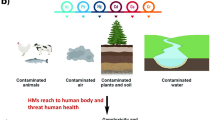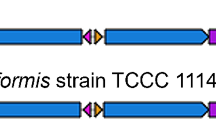Abstract
The mining and leakage of molybdenum (Mo) can cause environmental contamination which has not been realized until recently. Bacteria that can mitigate Mo-contamination was enriched and isolated. The low temperature and different pH conditions were considered to analysis its feasibility in Northern China which suffers from a long time of low temperatures every year. The result showed that the removal rate of MoO42− by Raoultella ornithinolytica A1 reached 30.46% at 25 °C and pH 7.0 in Luria–Bertani medium (LB). Meanwhile, A1 also showed some efficiency in the reduction of MoO42− in low phosphate molybdate medium (LPM), which reached optimum at the MoO42− concentration of 10 mM. The results of FTIR indicated that the cell wall performed an essential role in the MoO42− removal process, which was illustrated by the distribution of Mo in A1 (Mo bound to cell wall accounted for 92.29% of the total MoO42− removed). In addition, low temperature (10 °C) effect the removal rate of MoO42− by − 8.38 to 11.66%, indicating the potential for the in-situ microbial remediation of Mo-contaminated environments in low temperature areas.
Graphical abstract







Similar content being viewed by others
Data availability
All raw data is publicly available on the NCBI GenBank database (Accession Number: OP518431) and upon request.
References
Abd MH, Morsy FM, El AW, Ohyama T (2012) Isolation and characterization of a heavy-metal-resistant isolate of Rhizobium leguminosarum bv. Viciae potentially applicable for biosorption of Cd2+ and Co2+. Int Biodeterior Biodegrad 67:48–55. https://doi.org/10.1016/j.ibiod.2011.10.008
Abo-Shakeer LKA, Ahmad SA, Shukor MY, Shamaan NA, Syed MA (2013) Isolation and characterization of a molybdenum-reducing Bacillus pumilus strain lbna. J Materiomics 1:9–14. https://doi.org/10.54987/jemat.v1i1.18
Aubé BC, Stroiazzo J (2000) Molybdenum treatment at Brenda Mines. In: Proc. of 5th international conference on acid rock drainage, Society for Mining, Metallurgy, and Exploration (SME), Denver, Colorado
Bertoni FA, Gonzalez JC, Garcia SI, Sala LF, Bellu SE (2018) Application of chitosan in removal of molybdate ions from contaminated water and groundwater. Carbohyd Polym 180:55–62. https://doi.org/10.1016/j.carbpol.2017.10.027
Bostick BC, Fendorf S, Helz GR (2003) Differential adsorption of molybdate and tetrathiomolybdate on pyrite (FeS2). Environ Sci Technol 37:285–291. https://doi.org/10.1021/es0257467
Brune A, Dietz KJ (1995) A comparative analysis of element composition of roots and leaves of barley seedlings grown in the presence of toxic cadmium, molybdenum, nickel, and zinc concentrations. J Plant Nutr 18:853–868. https://doi.org/10.1080/01904169509364943
Campbell AM, Delcampillocampbell A, Villaret DB (1985) Molybdate reduction by Escherichia coli K-12 and its chl mutants. Proc Natl Acad Sci USA 82:227–231. https://doi.org/10.1073/pnas.82.1.227
Chen Y, Zhu Q, Dong X, Huang W, Du C, Lu D (2019) How Serratia marcescens HB-4 absorbs cadmium and its implication on phytoremediation. Ecotoxicol Environ Saf 185:109723. https://doi.org/10.1016/j.ecoenv.2019.109723
Choudhury S, Chatterjee A (2022) Microbial application in remediation of heavy metals: an overview. Arch Microbiol 204:1–15. https://doi.org/10.1007/s00203-022-02874-1
Dakora FD, Phillips DA (2002) Root exudates as mediators of mineral acquisition in low-nutrient environments. Plant Soil 245:35–47. https://doi.org/10.1023/A:1020809400075
Du GD, Guo ZP, Wang SQ, Zeng R, Chen ZX, Liu HK (2010) Superior stability and high capacity of restacked molybdenum disulfide as anode material for lithium ion batteries. Chem Commun 46:1106–1108. https://doi.org/10.1039/b920277c
Halmi MIE, Abdullah SRS, Wasoh H, Johari WLW, Ali MSM, Shaharuddin NA, Shukor MY (2016) Optimization and maximization of hexavalent molybdenum reduction to Mo-blue by Serratia sp. strain MIE2 using response surface methodology. Rend Lincei-Sci Fis 27:697–709. https://doi.org/10.1007/s12210-016-0552-4
Khayat ME, Abd Rahman MF, Shukor MS, Ahmad SA, Shamaan NA, Shukor MY (2016) Characterization of a molybdenum-reducing Bacillus sp. strain khayat with the ability to grow on SDS and diesel. Rend Lincei-Sci Fis. https://doi.org/10.1007/s12210-016-0519-5
Kumar D, Kviderova J, Kastanek P, Lukavsky J (2017) The green alga Dictyosphaerium chlorelloides biomass and polysaccharides production determined using cultivation in crossed gradients of temperature and light. Eng Life Sci 17:1030–1038. https://doi.org/10.1002/elsc.201700014
Lesperance A, Bohman V (1963) Effect of inorganic molybdenum and type of roughage on the bovine. J Anim Sci 22:686–694. https://doi.org/10.2527/jas1963.223686x
Lian JJ, Xu SG, Chang NB, Han CW, Liu JW (2013) Removal of molybdenum (VI) from mine tailing effluents with the aid of loessial soil and slag waste. Environ Eng Sci 30:213–220. https://doi.org/10.1089/ees.2011.0441
Lian JJ, Wang HL, He HP, Huang WL, Yang M, Zhong Y, Peng PA (2021a) The reaction of amorphous iron sulfide with Mo(VI) under different pH conditions. Chemosphere 266:128946. https://doi.org/10.1016/j.chemosphere.2020.128946
Lian JJ, Yang M, Wang HL, Zhong Y, Chen B, Huang WL, Peng PA (2021b) Enhanced molybdenum(VI) removal using sulfide-modified nanoscale zerovalent iron: kinetics and influencing factors. Water Sci Technol 83:297–308. https://doi.org/10.2166/wst.2020.570
Lima AIG, Corticeiro SC, Figueira E (2006) Glutathione-mediated cadmium sequestration in Rhizobium leguminosarum. Enzyme Microb Technol 39:763–769. https://doi.org/10.1016/j.enzmictec.2005.12.009
Liu X, Yang S, Wang YQ, Zhao HP, Song LY (2018) Metagenomic analysis of antibiotic resistance genes (ARGs) during refuse decomposition. Sci Total Environ 634:1231–1237. https://doi.org/10.1016/j.scitotenv.2018.04.048
Lv PL, Shi LD, Wang Z, Rittmann B, Zhao HP (2019) Methane oxidation coupled to perchlorate reduction in a membrane biofilm batch reactor. Sci Total Environ 667:9–15. https://doi.org/10.1016/j.scitotenv.2019.02.330
Mansur R, Gusmanizar N, Roslan MAH, Ahmad SA, Shukor MY (2017) Isolation and characterisation of a molybdenum-reducing and metanil yellow dye-decolourising Bacillus sp. strain Neni-10 in soils from west Sumatera, Indonesia. Trop Life Sci Res 28:69–90. https://doi.org/10.21315/tlsr2017.28.1.5
Masdor N, Shukor MS, Khan A, Halmi MIEB, Abdullan SRS, Shamaan NA, Shukor MY (2015) Isolation and characterization of a molybdenum-reducing and SDS-degrading Klebsiella oxytoca strain Aft-7 and its bioremediation application in the environment. Biodiversitas 16:238–246. https://doi.org/10.13057/biodiv/d160219
McGrath S, Micó C, Curdy R, Zhao F (2010a) Predicting molybdenum toxicity to higher plants: influence of soil properties. Environ Pollut 158:3095–3102. https://doi.org/10.1016/j.envpol.2010.06.027
McGrath S, Micó C, Zhao F, Stroud J, Zhang H, Fozard S (2010b) Predicting molybdenum toxicity to higher plants: estimation of toxicity threshold values. Environ Pollut 158:3085–3094. https://doi.org/10.1016/j.envpol.2010.06.027
Meeker JD, Rossano MG, Protas B, Diamond MP, Puscheck E, Daly D, Paneth N, Wirth JJ (2008) Cadmium, lead, and other metals in relation to semen quality: human evidence for molybdenum as a male reproductive toxicant. Environ Health Persp 116:1473–1479. https://doi.org/10.1289/ehp.11490
Naveed S, Li CH, Lu XD, Chen SS, Yin B, Zhang CH, Ge Y (2019) Microalgal extracellular polymeric substances and their interactions with metal(loid)s: a review. Crit Rev Environ Sci Tecnol 49:1769–1802. https://doi.org/10.1080/10643389.2019.1583052
Neunhäuserer C, Berreck M, Insam H (2001) Remediation of soils contaminated with molybdenum using soil amendments and phytoremediation. Water Air Soil Poll 128:85–96. https://doi.org/10.1023/A:1010306220173
Nishitani T, Shimada M, Kuroda K, Ueda M (2010) Molecular design of yeast cell surface for adsorption and recovery of molybdenum, one of rare metals. Appl Microbiol Biot 86:641–648. https://doi.org/10.1007/s00253-009-2304-1
Pabst MW, Miller CD, Dimkpa CO, Anderson AJ, McLean JE (2010) Defining the surface adsorption and internalization of copper and cadmium in a soil bacterium, Pseudomonas putida. Chemosphere 81:904–910. https://doi.org/10.1016/j.chemosphere.2010.07.069
Saeed AM, El Shatoury E, Hadid R (2019) Production of molybdenum blue by two novel molybdate-reducing bacteria belonging to the genus Raoultella isolated from Egypt and Iraq. J Appl Microbiol 126:1722–1728. https://doi.org/10.1111/jam.14254
Saeed AM, Sayed HA, El-Shatoury EH (2020) Optimizing the reduction of molybdate by two novel thermophilic bacilli isolated from Sinai, Egypt. Curr Microbiol 77:786–794. https://doi.org/10.1007/s00284-020-01874-y
Scott TB, Popescu IC, Crane RA, Noubactep C (2011) Nano-scale metallic iron for the treatment of solutions containing multiple inorganic contaminants. J Hazard Mater 186:280–287. https://doi.org/10.1016/j.jhazmat.2010.10.113
Shukor M, Habib S, Rahman M, Jirangon H, Abdullah M, Shamaan N, Syed M (2008) Hexavalent molybdenum reduction to molybdenum blue by S. marcescens strain Dr. Y6. Appl Biochem Biotechnol 149:33–43. https://doi.org/10.1007/s12010-008-8137-z
Shukor M, Rahman M, Shamaan NA, Syed M (2009) Reduction of molybdate to molybdenum blue by Enterobacter sp. strain Dr. Y13. J Basic Microb 49:S43–S54
Siddiquee S, Rovina K, Azad SA, Naher L, Suryani S, Chaikaew P (2015) Heavy metal contaminants removal from wastewater using the potential filamentous fungi biomass: a review. J Microb Biochem Technol 7:384–393. https://doi.org/10.4172/1948-5948.1000243
Siripornadulsil S, Siripornadulsil W (2013) Cadmium-tolerant bacteria reduce the uptake of cadmium in rice: potential for microbial bioremediation. Ecotoxicol Environ Saf 94:94–103. https://doi.org/10.1016/j.ecoenv.2013.05.002
Smedley PL, Kinniburgh DG (2017) Molybdenum in natural waters: a review of occurence, distributions and controls. Appl Geochem 84:387–432. https://doi.org/10.1016/j.apgeochem.2017.05.008
Suttle N (1991) The interactions between copper, molybdenum, and sulphur in ruminant nutrition. Annu Rev Nutr 11:121–140. https://doi.org/10.1146/annurev.nu.11.070191.001005
Townshend A (1993) Metals and their compounds in the environment. Occurrence, analysis and biological relevance. Elsevier
Tucker MD, Barton LL, Thomson BM (1997) Reduction and immobilization of molybdenum by Desulfovibrio desulfuricans. J Environ Qual 26:1146–1152. https://doi.org/10.2134/jeq1997.00472425002600040029x
Vyskočil A, Viau C (1999) Assessment of molybdenum toxicity in humans. J Appl Toxicol 19:185–192. https://doi.org/10.1002/(SICI)1099-1263(199905/06)19:3
Walravens PA, Moure-Eraso R, Solomons CC, Chappell WR, Bentley G (1979) Biochemical abnormalities in workers exposed to molybdenum dust. Arch Environ Occup H 34:302–308. https://doi.org/10.1080/00039896.1979.10667421
Wang L, Li ZT, Wang Y, Brookes PC, Wang F, Zhang QC, Xu JM, Liu XM (2021a) Performance and mechanisms for remediation of cd(II) and as(III) co-contamination by magnetic biochar-microbe biochemical composite: competition and synergy effects. Sci Total Environ 750:141672. https://doi.org/10.1016/j.scitotenv.2020.141672
Wang X, Brunetti G, Tian W, Owens G, Qu Y, Jin C, Lombi E (2021b) Effect of soil amendments on molybdenum availability in mine affected agricultural soils. Environ Pollut 269:116132. https://doi.org/10.1016/j.envpol.2020.116132
Ward J, Spears J (1999) The effects of low-copper diets with or without supplemental molybdenum on specific immune responses of stressed cattle. J Anim Sci 77:230–237. https://doi.org/10.2527/1999.771230x
Warington K (1955) The influence of high concentrations of ammonium and sodium molybdates on flax, soybean and peas grown in nutrient solutions containing deficient or excess iron. Ann Appl Biol 43:709–719. https://doi.org/10.1111/j.1744-7348.1955.tb02514.x
Wei J, Xie X, Huang F, Xiang L, Wang Y, Han T, Massey IY, Liang G, Pu Y, Yang F (2020) Simultaneous microcystis algicidal and microcystin synthesis inhibition by a red pigment prodigiosin. Environ Pollut 256:113444. https://doi.org/10.1016/j.envpol.2019.113444
Wen LL, Zhang Y, Pan YW, Wu WQ, Meng SH, Zhou C, Tang YN, Zheng P, Zhao HP (2015) The roles of methanogens and acetogens in dechlorination of trichloroethene using different electron donors. Environ Sci Pollut R 22:19039–19047. https://doi.org/10.1007/s11356-015-5117-z
Who (2011) Guidelines for drinking Water Quality. fourth ed. World Health Organization. http://whqlibdoc.who.int/publications/2011/9789241548151_eng.pdf
Wu HY, Liu YT, Chen B, Yang F, Wang LM, Kong QP, Ye TR, Lian JJ (2021) Enhanced adsorption of molybdenum(VI) from aquatic solutions by chitosan-coated zirconium-iron sulfide composite. Sep Purif Technol 279:119736. https://doi.org/10.1016/j.seppur.2021.119736
Yakasai H, Karamba K, Yasid N, Halmi M, Rahman M, Ahmad S, Shukor M (2019) Response surface-based optimization of a novel molybdenum-reducing and cyanide-degrading Serratia sp. strain HMY1. Desalin Water Treat 145:220–231. https://doi.org/10.5004/dwt.2019.23734
Yakasai HM, Rahman MF, Manogaran M, Yasid NA, Syed MA, Shamaan NA, Shukor MY (2021) Microbiological reduction of molybdenum to molybdenum blue as a sustainable remediation tool for molybdenum: a comprehensive review. Int J Environ Res Public Health 18:5731. https://doi.org/10.3390/ijerph18115731
Yu M, Hu CX, Sun XC, Wang YH (2010) Influences of Mo on nitrate reductase, glutamine synthetase and nitrogen accumulation and utilization in Mo-efficient and Mo-inefficient winter wheat cultivars. Agr Sci China 9:355–361. https://doi.org/10.1016/S1671-2927(09)60104-8
Acknowledgements
The authors thank Heilongjiang Provincial Research Academy of Environmental Sciences for financial support, and Harbin Institute of Technology for technical assistance in the laboratory.
Funding
This work was financially supported by the Scientific Research Project of the Heilongjiang Provincial Institute of Scientific Research.
Author information
Authors and Affiliations
Contributions
Study design and organization were performed by JX. Experiment operation and sample analysis, writing-review and editing were performed by CL, WL, XZ and ZL. Conceptualization, formal analysis, writing-review and editing were performed by AL. All authors improved the manuscript through comments and text suggestions and all authors approved the final manuscript.
Corresponding author
Ethics declarations
Competing interests
The authors have no relevant financial or non-financial interests to disclose.
Additional information
Publisher’s Note
Springer Nature remains neutral with regard to jurisdictional claims in published maps and institutional affiliations.
Supplementary Information
Below is the link to the electronic supplementary material.
Rights and permissions
Springer Nature or its licensor (e.g. a society or other partner) holds exclusive rights to this article under a publishing agreement with the author(s) or other rightsholder(s); author self-archiving of the accepted manuscript version of this article is solely governed by the terms of such publishing agreement and applicable law.
About this article
Cite this article
Xing, J., Li, C., Li, W. et al. Isolation and identification of the molybdenum-resistant strain Raoultella ornithinolytica A1 and its effect on MoO42− in the environment. Biodegradation 34, 169–180 (2023). https://doi.org/10.1007/s10532-022-10011-4
Received:
Accepted:
Published:
Issue Date:
DOI: https://doi.org/10.1007/s10532-022-10011-4




